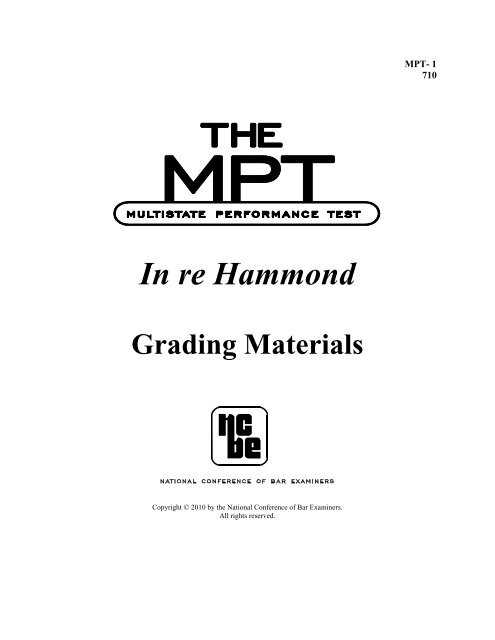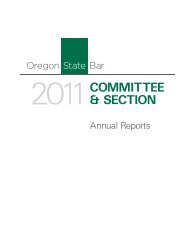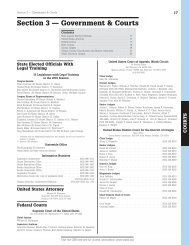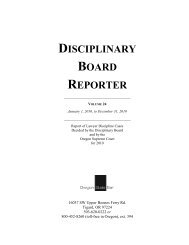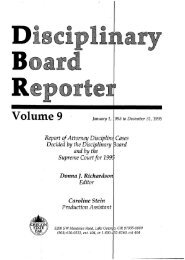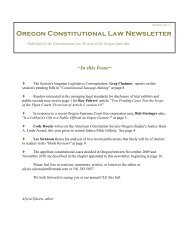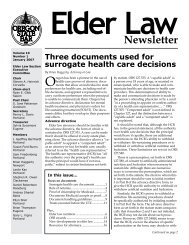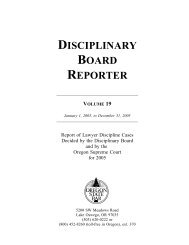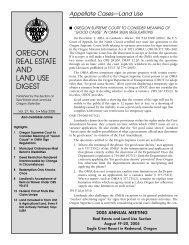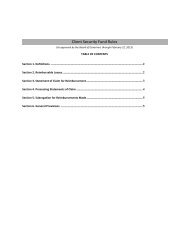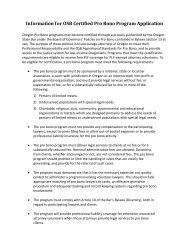MPT Grading Materials July 2010 - Oregon State Bar
MPT Grading Materials July 2010 - Oregon State Bar
MPT Grading Materials July 2010 - Oregon State Bar
You also want an ePaper? Increase the reach of your titles
YUMPU automatically turns print PDFs into web optimized ePapers that Google loves.
<strong>MPT</strong>- 1<br />
710<br />
In re Hammond<br />
<strong>Grading</strong> <strong>Materials</strong><br />
Copyright © <strong>2010</strong> by the National Conference of <strong>Bar</strong> Examiners.<br />
All rights reserved.
The <strong>MPT</strong> point sheet, grading summary, and grading guidelines describe the factual and legal points<br />
encompassed within the lawyering task to be completed. They outline all the possible issues and points<br />
that might be addressed by an applicant. They are provided to the user jurisdictions for the sole purpose of<br />
assisting graders in grading the examination by identifying the issues and suggesting the resolution of the<br />
problem contemplated by the drafters. These are not official grading guides. Applicants can receive a<br />
range of passing grades, including excellent grades, without covering all the points discussed in these<br />
guides. The model answer is included as an illustration of a thorough and detailed response to the task,<br />
one that addresses all the legal and factual issues the drafters intended to raise in the problem. It is<br />
intended to serve only as an example. Applicants need not present their responses in the same way to<br />
receive good grades. User jurisdictions are free to modify these grading materials, including the suggested<br />
weights assigned to particular points. <strong>Grading</strong> the <strong>MPT</strong> is the exclusive responsibility of the jurisdiction<br />
using the <strong>MPT</strong> as part of its admissions process.
Point Sheet
In re Hammond<br />
DRAFTERS’ POINT SHEET<br />
In this performance test item, applicants work for a law firm. A partner in the firm, Jane<br />
Spencer, has received a request for guidance from another attorney, Carol Walker, who<br />
represents William Hammond, who, as a result of a suspicious fire, suffered the loss of a<br />
building that he owned and that housed his business. Hammond has sought Walker’s advice<br />
about whether he has any criminal exposure and whether he may file an insurance claim for the<br />
loss of the building. Walker has suspicions that Hammond may have been involved in the fire,<br />
but Hammond has not explicitly admitted nor denied involvement and Walker has not explicitly<br />
asked.<br />
Walker seeks advice from the applicants’ firm on whether she can successfully move to<br />
quash a subpoena duces tecum issued by the District Attorney compelling her to appear before a<br />
grand jury convened to investigate the fire and to testify and produce materials relating to her<br />
communications with Hammond about the fire. Walker desires not to appear, and Hammond<br />
desires that she not disclose any of their communications.<br />
Applicants’ task is to prepare a brief in support of a motion to quash the subpoena on the<br />
grounds that under the Franklin Rules of Professional Conduct and the Franklin Rules of<br />
Evidence, Walker may not be compelled to give the testimony or produce the materials in<br />
question.<br />
The File contains a memorandum describing the task, a memorandum on persuasive<br />
briefs, a letter from Walker to Spencer, a memorandum to file by Walker summarizing a meeting<br />
with Hammond, another memorandum to file by Walker summarizing a telephone conversation<br />
with Ray Gomez (a friend of Hammond), a police incident report, the subpoena duces tecum, and<br />
a draft of the motion to quash the subpoena.<br />
The Library contains a provision of the Franklin Rules of Professional Conduct relating<br />
to the ethical duty of confidentiality, a provision of the Franklin Rules of Evidence relating to the<br />
attorney-client privilege and the crime-fraud exception, and provisions of the Franklin Criminal<br />
Code relating to arson. The Library also contains two decisions from jurisdictions outside<br />
Franklin bearing on a question, unresolved in Franklin, involving the attorney-client privilege<br />
and the crime-fraud exception.<br />
1
I. Detailed Analysis<br />
The following discussion covers all the points the drafters intended to raise in the<br />
problem. Applicants need not cover them all to receive passing or even excellent grades.<br />
<strong>Grading</strong> decisions are left to the discretion of the user jurisdictions.<br />
In arguing the motion to quash the subpoena duces tecum, applicants must address two<br />
separate questions: First, may Walker be compelled to appear before the grand jury to disclose<br />
her communications with Hammond about the fire, whether by testimony or by production of<br />
materials, under the Franklin Rules of Professional Conduct? Second, may she be compelled to<br />
do so under the Franklin Rules of Evidence? As will appear, applicants should give a negative<br />
answer to each question.<br />
In the call memo, applicants are urged to remain faithful to the Franklin Rules of<br />
Professional Conduct and observe client confidences. This requires applicants to distinguish<br />
carefully between those facts that are not protected by ethical and evidentiary rules and those that<br />
are protected, including any communications between Walker and Gomez and any suspicions<br />
Walker may have about Hammond’s involvement in the fire.<br />
• Applicants should include in their arguments only those facts that are not protected, as<br />
the task memorandum underscores the importance of maintaining client confidences.<br />
A. Whether Walker May Be Compelled to Appear before the Grand Jury to Disclose<br />
Her Communications with Hammond under the Franklin Rules of Professional Conduct<br />
The first question for applicants to address is whether Walker may be compelled to<br />
appear before the grand jury to disclose her communications with Hammond about the fire,<br />
whether by testimony or by production of materials, under the Franklin Rules of Professional<br />
Conduct.<br />
Under Rule 1.6 of the Franklin Rules of Professional Conduct—which is identical to Rule<br />
1.6 of the American <strong>Bar</strong> Association’s Model Rules of Professional Conduct, the source of many<br />
jurisdictions’ analogous rules—a lawyer may not, as a general matter, reveal information relating<br />
to the representation of a client, whether or not that information consists of a communication<br />
between lawyer and client, and whether or not it is confidential.<br />
• It is plain that the communications between Walker and Hammond about the fire fall<br />
within the general rule of confidentiality.<br />
2
• On their face, they contain information relating to the representation and are<br />
confidential communications between lawyer and client.<br />
• There are, however, three exceptions to Rule 1.6. The lawyer may make a disclosure<br />
• (a) if the client gives informed consent,<br />
• (b) if the disclosure is impliedly authorized in order to carry out the<br />
representation, and<br />
• (c) if any one of certain circumstances is found to exist—here, specifically, “to<br />
prevent, mitigate or rectify substantial injury to the financial interest or property<br />
of another that is reasonably certain to result or has resulted from the client’s<br />
commission of a crime or fraud in furtherance of which the client has used the<br />
lawyer’s services.”<br />
The exceptions to Rule 1.6 do not apply to Walker/Hammond communications<br />
• The first exception, client consent, is not present. Hammond has not given Walker<br />
consent, informed or otherwise, to disclose their communications about the fire to the<br />
grand jury.<br />
• Indeed, he specifically requested that she not do so.<br />
• Neither is the second exception present. Disclosure of the communications between<br />
Walker and Hammond about the fire to the grand jury or otherwise is not impliedly<br />
authorized in order to carry out Walker’s representation of Hammond.<br />
• Again, Hammond has specifically requested that she make no such disclosure.<br />
• Finally, the specified circumstance (the third exception) is apparently inapplicable at the<br />
threshold. That circumstance would be applicable only if Walker were to reasonably<br />
believe that disclosure of her communications with Hammond about the fire was<br />
necessary to “prevent, mitigate or rectify substantial injury to the financial interest or<br />
property of another that is reasonably certain to result or has resulted from” Hammond’s<br />
“commission of a crime or fraud in furtherance of which” he “has used” her “services.”<br />
• The very fact that Walker is seeking to quash the subpoena reveals that she has no<br />
such belief—and certainly has no such belief that disclosure to the grand jury is<br />
necessary.<br />
• In any event, it appears that “substantial injury to the financial interest or property<br />
of another” could result only if Hammond filed a fraudulent insurance claim.<br />
• That Hammond will do so is not “reasonably certain.”<br />
3
• Walker has advised Hammond that if he was involved in any way in the<br />
fire, he cannot collect insurance and may face criminal charges.<br />
• At the present time, without knowing the cause of the fire or whether<br />
Hammond will file an insurance claim, it is unreasonable, indeed<br />
speculative, to conclude that financial injury to a third party (i.e., the<br />
insurer) will occur.<br />
• Thus, there is little basis for concluding that Walker has an obligation to<br />
reveal any client confidences.<br />
• Further, the language of Rule 1.6(b) is permissive (e.g., “a lawyer may reveal<br />
information…”) not mandatory, so even if an exception applied, the rules would not<br />
require Walker to disclose the communications.<br />
In light of the foregoing, applicants should argue that Walker may not be compelled to<br />
appear before the grand jury to disclose her communications with Hammond about the fire,<br />
whether by testimony or by production of materials, under the Franklin Rules of Professional<br />
Conduct.<br />
B. Whether Walker May Be Compelled to Appear before the Grand Jury to Disclose Her<br />
Communications with Hammond under the Franklin Rules of Evidence<br />
The second question for applicants to address is whether Walker may be compelled to<br />
appear before the grand jury to disclose her communications with Hammond about the fire,<br />
whether by testimony or by production of materials, under the Franklin Rules of Evidence.<br />
Summary of the applicable law<br />
Under Rule 513 of the Franklin Rules of Evidence (which is similar to the lawyer-client<br />
evidentiary privilege in many jurisdictions), a client “has a privilege to refuse to disclose and to<br />
prevent any other person from disclosing a confidential communication made for the purpose of<br />
facilitating the rendition of” a lawyer’s services. There is no privilege, however, if the client<br />
sought or obtained a lawyer’s services in furtherance of a crime or fraud.<br />
4
A confidential communication between a client and a lawyer is presumed to be<br />
privileged. To rebut the presumption, a party claiming otherwise must carry the burden of proof<br />
by a preponderance of the evidence. A party claiming that a confidential communication is<br />
privileged must nevertheless disclose the communication to the court to determine the<br />
communication’s status if a party claiming that the communication is not privileged presents<br />
evidence sufficient to raise a substantial question about the communication’s status. Franklin<br />
courts have not yet determined whether, to be sufficient, the evidence presented must establish<br />
probable cause to believe that the communication is not privileged, see, e.g., <strong>State</strong> v. Sawyer<br />
(Columbia Sup. Ct. 2002), or whether there must merely be “some evidence” to that effect, see,<br />
e.g., United <strong>State</strong>s v. Robb (15th Cir. 1999).<br />
• The Walker/Hammond communications are presumed to be privileged.<br />
• From all that appears, all communications between Hammond and Walker about the fire<br />
were confidential and all were made for the purpose of facilitating the rendition of<br />
Walker’s services as a lawyer to Hammond as a client.<br />
• Therefore, all the communications in question are presumed privileged because they were<br />
confidential and are in fact privileged because they were not only confidential but were<br />
also made with a view toward the rendering of legal services.<br />
• Hammond has impliedly (if not expressly) authorized, and instructed, Walker to claim the<br />
privilege on his behalf and to refuse to disclose any of the communications to the grand<br />
jury through his expressed desire that Walker not disclose any communications.<br />
• As things stand, the Gordon County District Attorney cannot carry her burden of proof by<br />
a preponderance of the evidence that any of the communications between Hammond and<br />
Walker about the fire were not privileged by virtue of the crime-fraud exception.<br />
• The District Attorney’s evidence establishes the following:<br />
• the building housing the Hammond Container Company was destroyed by fire;<br />
• Hammond owned the business and the building;<br />
• Hammond had insured the building;<br />
• Hammond has made inquiries about filing an insurance claim, but has not filed such a<br />
claim;<br />
• Hammond sought a bank loan prior to the fire, and was turned down because of his<br />
company’s financial condition;<br />
• the Fire Marshal classified the fire as suspicious in origin;<br />
5
• Hammond has not been willing to fully cooperate with the police;<br />
• there is a discrepancy between what Hammond and his friend Gomez said they were<br />
doing the day of the fire; and<br />
• Hammond retained Walker two days after the fire.<br />
• To be sure, this evidence supports an inference that Hammond may have committed<br />
arson with the intent to defraud the insurer of his building and may intend to carry<br />
through by filing a fraudulent insurance claim.<br />
• Even if he caused the fire, Hammond has not violated Fr. Criminal Code § 3.01,<br />
Arson of Building, because that makes it a crime to damage with fire the building of<br />
another, not one’s own building.<br />
• But the evidence does not support an inference that Hammond sought or obtained<br />
Walker’s services to further any such crime or fraud. True, the evidence allows<br />
conjecture about Hammond’s purpose in retaining Walker, but it does not point to an<br />
improper purpose—to further a crime or fraud—rather than a proper one—to defend<br />
against an accusation of a crime or fraud.<br />
• Whether the Gordon County District Attorney has sufficient evidence to require Walker to<br />
disclose her communications with Hammond about the fire for the court to determine their<br />
status (in camera) as privileged or nonprivileged depends upon whether the District Attorney<br />
has evidence sufficient to raise a substantial question about their status.<br />
• Whether the District Attorney has such evidence may depend in turn on whether the court<br />
would apply the stricter “probable cause” standard or the looser “some evidence”<br />
standard. Applicants should argue that the stricter standard applies.<br />
• If the court should apply the “probable cause” standard, the Gordon County District<br />
Attorney’s evidence would be insufficient to require Walker to disclose her<br />
communications with Hammond about the fire for the court to determine their status as<br />
privileged or nonprivileged.<br />
• As explained, although the evidence supports an inference that Hammond may have<br />
committed arson with the intent to defraud the insurer of his building and may intend<br />
to carry through by filing a fraudulent insurance claim, it does not support an<br />
inference that Hammond sought or obtained Walker’s services to further any such<br />
crime or fraud.<br />
6
• Hammond requested claim forms and information from Mutual Insurance before<br />
he hired Walker (see Police Report). Thus, it is unlikely that he sought advice<br />
from Walker about how to submit an insurance claim—he had already obtained<br />
such information.<br />
• Moreover, the nature of the potential crime in this instance—insurance fraud—is<br />
not comparable to the complex financial fraud perpetrated by the defendant in<br />
Robb. In short, it is not the type of crime for which one would necessarily need<br />
legal advice to commit.<br />
• There is evidence that Hammond had a motive to commit insurance fraud, but the<br />
police report notes only that the bank denied Hammond’s application for a<br />
business loan. The more damaging information—Hammond’s statements to<br />
Walker that he had been having financial problems and could not make his next<br />
payroll or mortgage payment—is found only in the privileged attorney-client<br />
communications at issue. Thus those statements are not available to the district<br />
attorney at this stage in the proceedings.<br />
• Applicants who divulge what Hammond told Walker regarding his dire<br />
financial straits may receive less credit for their discussion, as they will have<br />
violated client confidentiality.<br />
• If the court should apply the “some evidence” standard, the Gordon County District<br />
Attorney’s evidence would arguably remain insufficient to require Walker to disclose her<br />
communications with Hammond about the fire for the court to determine their status as<br />
privileged or nonprivileged.<br />
• It is true that the “some evidence” standard may apparently be satisfied by a client’s<br />
retention of a lawyer “in the midst of a fraudulent scheme.” United <strong>State</strong>s v. Robb<br />
(15th Cir. 1999).<br />
• But whether Hammond is indeed involved in a “fraudulent scheme” is the very<br />
question to be resolved. To assume that he is involved simply begs the question. As<br />
stated, he sought advice about whether he could file an insurance claim, not how he<br />
could do so.<br />
• The Fire Marshal’s report failed to find specific evidence of the cause of the fire,<br />
but classified it as suspicious. At this point in time, there is no determination that<br />
7
the fire was intentionally set. [Contrast with Robb, in which there was clear<br />
evidence of manipulation of the price of the mining stock.]<br />
• Just burning down his own building is not arson. Frank. Crim. Code § 3.01.<br />
• By contrast, in Robb, there was evidence available to the government that the<br />
defendant had employed his lawyer in the midst of his fraudulent mining scheme, and<br />
the actual mining records revealed the misrepresentations in the publicly disseminated<br />
information. Accordingly, the government met the “some evidence” standard required<br />
to trigger in camera review of the attorney-client communications.<br />
• The Walker/Hammond relationship appears much closer to that in <strong>State</strong> v. Sawyer<br />
(Columbia Sup. Ct. 2002): “While the evidence would indeed support an inference<br />
that Krause retained Novak to facilitate perjury, it supports an equally strong<br />
inference that Krause retained him to ensure that his choices were informed—and that<br />
he failed to cooperate earlier because he was afraid he might expose himself to<br />
prosecution with no countervailing benefit.”<br />
• There is an equally strong inference that Hammond, realizing that his financial<br />
situation made him a prime suspect in an arson investigation, retained Walker to<br />
ensure that he had sound legal advice in responding to police inquiries.<br />
• Finally, it can be argued that the same public policy underlying the existence of the<br />
attorney/client privilege—encouraging clients to fully and frankly disclose matters to<br />
their attorneys—also supports the Franklin courts adopting a probable cause standard.<br />
• “[T]he attorney-client privilege [is] the oldest of the privileges for confidential<br />
communications known to the common law. It encourages full and frank<br />
communication between attorneys and clients….” Robb.<br />
• Robb recognized that the low “some evidence” standard had the potential to lead to<br />
infringement of confidentiality between attorney and client. But the Robb court<br />
reasoned that because of the risk that a higher standard could “improperly cloak<br />
fraudulent or criminal activities,” the “some evidence” standard was appropriate. Id.<br />
• It could be argued that the Robb standard encourages fishing expeditions into<br />
privileged communications and that it could have a chilling effect on the attorneyclient<br />
relationship. Sawyer is the better approach. Franklin should join Columbia in<br />
requiring a “strong factual basis for the inference” that the crime-fraud exception<br />
8
applies and the privileged communications should be submitted to the court for in<br />
camera review.<br />
• Opting for the probable-cause standard, as in Sawyer, will better protect the<br />
importance of maintaining the confidentiality of attorney-client communications and<br />
yet is not an insurmountable bar to those parties who believe that there is a substantial<br />
question regarding whether such communications are entitled to the privilege.<br />
• In any event, no matter which standard the court might apply, and even if the court might end<br />
up requiring Walker to disclose her communications with Hammond about the fire so as to<br />
determine their status as privileged or nonprivileged, the result would likely be the same: The<br />
court would likely conclude that the communications were in fact privileged inasmuch as<br />
they are presumed to be such in light of their confidential character and the presumption is<br />
not rebutted by a preponderance of evidence proving the crime-fraud exception.<br />
In light of the foregoing, applicants should argue that Walker may not be compelled to<br />
appear before the grand jury to disclose her communications with Hammond, whether by<br />
testimony or by production of materials, under the Franklin Rules of Evidence.<br />
9
<strong>Grading</strong> Summary<br />
and<br />
<strong>Grading</strong> Guidelines
Multistate Performance Test<br />
GRADING SUMMARY<br />
In re Hammond<br />
William Hammond is the subject of a grand jury arson investigation as a result of a suspicious fire that<br />
burned down the building that housed his company, the Hammond Container Co. His attorney, Carol<br />
Walker, has been subpoenaed to testify and produce materials relating to their communications.<br />
Applicants’ task is to draft a brief in support of a motion to quash arguing that under the Rules of Prof.<br />
Conduct and Evidence, Walker may not be compelled testify or to produce the materials in question.<br />
Disclosure Is Not Appropriate under the Fr. Rules of Prof. Conduct (35% total weight)<br />
• Rule 1.6 prohibits disclosure of client communications; no exceptions apply here.<br />
• Hammond does not consent to disclosure. He has told Walker not to disclose anything.<br />
• No facts support Hammond’s implied authorization to disclose to carry out the representation.<br />
• Clearly Walker does not believe disclosure is necessary “to prevent … substantial injury to<br />
the financial interest … of another that is reasonably certain to result.” Rule 1.6(b)(3)<br />
• No insurance claim has been filed; there is no imminent injury to another’s financial interest.<br />
• Thus, it is not “reasonably certain” that injury to another will occur.<br />
• By challenging the subpoena, Walker is demonstrating her belief that no disclosure is necessary<br />
to mitigate or rectify any harm to a third party or that Hammond has used her services in<br />
furtherance of the commission of a crime.<br />
• There are no facts that counter Walker’s belief that disclosure of information regarding<br />
Hammond’s representation/case is not needed in order to prevent financial injury to another.<br />
• Further, Rule 1.6(b) is permissive (e.g., “a lawyer may reveal information…”), not mandatory, so<br />
even if an exception applied, the rules would not require Walker to disclose the communications.<br />
Fr. Rules of Evidence Do Not Compel Disclosure of A/C Communications (65% total weight)<br />
• Confidential A/C communications are presumed privileged. Fr. R. Evid. 513. (25%)<br />
• Walker may claim the privilege on Hammond’s behalf. Fr. R. Evid. 513(b)(3).<br />
• A preponderance of the evidence is required to overcome the presumption. Rule 513 cmt.<br />
• The crime/fraud exception to the privilege. (Rule 513(d)(1)) does not apply.<br />
• The proof needed for in camera review re: privilege is an open question in Franklin.<br />
• Columbia requires probable cause to believe the communication is not privileged. Sawyer.<br />
• The 15th Circuit requires only the “some evidence” standard. Robb.<br />
• Applicants should argue for the stricter probable cause standard on public policy grounds, but note<br />
that the DA doesn’t even have enough to meet the “some evidence” standard and so no substantial<br />
question is raised regarding the communications’ status. (40%)<br />
• The evidence may support an inference that Hammond committed arson with intent to defraud,<br />
as the building was insured for $500k. Fr. Crim. Code § 3.02; police report.<br />
• The Fire Marshal called the fire “suspicious”; Hammond hasn’t fully cooperated with police;<br />
he’s said he was with a friend on the day of the fire, but the friend denies it. See police report.<br />
• Hammond contacted his insurer about filing an insurance claim (but has not yet filed it). Id.<br />
• Hammond has financial problems: he was denied a loan and has a $425k mortgage. Id.<br />
• But it is unreasonable to infer that Hammond retained Walker in furtherance of a crime.<br />
• Hammond may have wanted to obtain counsel because he knew he was under investigation.<br />
No publicly available evidence points to an ongoing scheme to defraud, as in Robb.<br />
• Hammond hired Walker after the fire, which cuts against applying crime-fraud exception.<br />
• Past/completed crimes do not fall under the crime/fraud exception. See Rule 513(d)(1).<br />
11
Multistate Performance Test<br />
In re Hammond<br />
<strong>Grading</strong> Guidelines<br />
I. Overview <strong>Grading</strong> Comments<br />
• Applicants’ law firm represents attorney Carol Walker,<br />
who has been subpoenaed by the grand jury in an arson<br />
investigation to appear with regard to her client William<br />
Hammond.<br />
• Hammond’s building, which housed his business,<br />
burned down on May 10. He hired Walker two days<br />
after the fire, after being contacted by the police.<br />
This section is informative only<br />
and no grading weight is<br />
assigned.<br />
No discrete weight is assigned to<br />
the “format” component of the<br />
task.<br />
• Walker does not want to appear before the grand jury.<br />
• Applicants’ task is to craft the arguments in support of the<br />
motion to quash the subpoena.<br />
• There are two issues to address: whether disclosure may be<br />
compelled under the Franklin Rules of Professional<br />
Conduct or the Franklin Rules of Evidence.<br />
• Franklin Rule of Prof. Conduct 1.6 is identical to Rule<br />
1.6 of the ABA’s Model Rules.<br />
• Franklin Rule of Evidence 513 is similar to the lawyerclient<br />
evidentiary privilege in many jurisdictions.<br />
• Applicants should argue that disclosure of the attorneyclient<br />
communications between Walker and Hammond<br />
cannot be compelled under either the Franklin Rules of<br />
Professional Conduct or the Franklin Rules of Evidence.<br />
II. Walker may not be compelled to testify under Fr. Rule of<br />
Professional Conduct 1.6.<br />
• Under Rule 1.6, a lawyer may not reveal information<br />
relating to the representation of a client. The information<br />
need not be a lawyer-client communication, nor must it be<br />
confidential—it need only relate to the representation for<br />
the rule to apply.<br />
• Rule 1.6 is broader than the evidentiary privilege (Fr.<br />
R. Evid. 513), which applies only to communications<br />
between the lawyer and client.<br />
• All the Hammond/Walker communications in the file fall<br />
within the rule, as well as the memos from Walker’s file.<br />
• The Walker/Gomez communications relate to Walker’s<br />
representation of Hammond and are covered by R. 1.6.<br />
• There are exceptions to the Rule when (1) the client gives<br />
informed consent to disclosure, or (2) disclosure is<br />
impliedly authorized to carry out the representation.<br />
• Note that Hammond specifically requested that Walker<br />
not disclose any of their communications.<br />
• Nor do the facts support any conclusion that Hammond<br />
implicitly authorized any disclosure by Walker.<br />
12<br />
No separate statement of facts is<br />
required, but applicants should<br />
incorporate the facts into their<br />
analyses. Applicants are told to<br />
use descriptive section headings.<br />
The assignment is to draft an<br />
argument. Work product that is<br />
objective in tone is not<br />
responsive to the instructions.<br />
(35% total weight)<br />
Reduced credit for applicants<br />
who disclose too many facts<br />
which are privileged and so not<br />
known to the DA. Only the fact<br />
that Hammond retained Walker<br />
and the date of her<br />
representation, and the fact that<br />
she advised him to refer any<br />
questions to her (see Police<br />
Report) should be mentioned.<br />
The other listed exceptions in<br />
subsection (b), to prevent death<br />
or bodily harm, or to comply<br />
with law or a court order, plainly<br />
do not apply.
Multistate Performance Test<br />
In re Hammond<br />
<strong>Grading</strong> Guidelines<br />
• Other exceptions may apply if certain circumstances exist<br />
under Rule 1.6(b).<br />
• The relevant inquiry here is Rule 1.6(b)(3): Is disclosure<br />
necessary “to prevent, mitigate or rectify substantial injury<br />
to the financial interest or property of another that is<br />
reasonably certain to result or has resulted from the client’s<br />
commission of a crime or fraud in furtherance of which the<br />
client has used the lawyer’s services”?<br />
• The facts do not suggest that Walker reasonably believes<br />
that disclosure is necessary to prevent injury to the<br />
financial interest of another that is reasonably certain to<br />
result or has resulted from Hammond’s “commission of a<br />
crime or fraud in furtherance of which” he has used<br />
Walker’s services.<br />
• The very fact that Walker is seeking to quash the<br />
subpoena presumably indicates that she has no such<br />
belief—and certainly has no belief that disclosure to<br />
the grand jury is necessary.<br />
• Hammond is suspected of burning down his own building.<br />
Thus, he can only cause injury to the financial interest of<br />
another if he files an insurance claim for the loss (building<br />
is insured for $500,000). § 3.02, Fr. Crim. Code.<br />
• It’s not certain that Hammond will attempt to file a claim<br />
with his insurance company.<br />
• Applicants should use these facts to assert that Hammond<br />
has done nothing wrong but is merely acting prudently<br />
after having been contacted by police regarding the fire.<br />
• Better answers will note that this is an ethical obligation,<br />
not an evidentiary privilege; thus, there is not a dispute<br />
regarding the level of evidence. Rule 1.6(b) is a permissive<br />
rule under which an attorney who reasonably believes<br />
disclosure is necessary to prevent financial harm or injury<br />
to another may disclose client information.<br />
• In fact, the prohibition on disclosure is mandatory (“a<br />
lawyer shall not…”). By challenging the subpoena, Walker<br />
is simply complying with her ethical responsibilities under<br />
Rule 1.6.<br />
III. Walker may not be compelled to testify under the Fr. Rules<br />
of Evidence<br />
• Confidential attorney-client communications are presumed<br />
privileged against disclosure. Fr. R. Evid. 513.<br />
13<br />
Of course, the fire has adversely<br />
affected the bank’s security<br />
interest in the warehouse. But<br />
again, that is a completed<br />
act/injury, predating Walker’s<br />
representation of Hammond.<br />
Note to Graders: The fact that<br />
Walker advised Hammond not to<br />
file a claim if he was anyway<br />
involved in the fire and that he<br />
could face criminal charges if he<br />
did so, is a confidential A/C<br />
communication. Those applicants<br />
who cite the specific advice<br />
Walker gave Hammond are in<br />
breach of their ethical obligation<br />
not to disclose client<br />
confidences.<br />
Less credit may be given to those<br />
applicants who discuss the Robb<br />
and Sawyer evidentiary standards<br />
in this section of their argument.<br />
(65% total weight)
Multistate Performance Test<br />
In re Hammond<br />
• Walker has claimed the privilege on Hammond’s<br />
behalf.<br />
• The privilege may be overcome if the party seeking to<br />
defeat it shows by a preponderance of the evidence that the<br />
communications fall within an exception to the privilege.<br />
• There is no privilege if the attorney’s services were used or<br />
obtained in furtherance of a crime or fraud. Id. 513(d)(1).<br />
• Thus, a completed crime (e.g., arson) does not come<br />
within the exception.<br />
• Because the DA is claiming that the communications are<br />
not privileged, the DA must present evidence to the court<br />
raising a substantial question about the communications’<br />
status.<br />
• The appropriate standard of proof required for the court to<br />
review the A/C communications in camera and determine<br />
their status is undecided in Franklin.<br />
• Columbia utilizes a “probable cause” standard. Sawyer.<br />
• There must be a “strong factual basis for the inference<br />
that the client retained the attorney for improper<br />
purposes.” Id.<br />
• In Sawyer, the evidence equally supported the inference<br />
that the attorney was retained to facilitate perjury by the<br />
client and the inference that the client realized that he<br />
should have legal advice before cooperating with the<br />
prosecution. Accordingly, there was not probable cause to<br />
conclude that the attorney was retained to further a crime<br />
or fraud and the communications were privileged.<br />
• Hammond’s failure to fully cooperate with the police<br />
should be viewed as in Sawyer—the prudent act of a man<br />
who realizes that he is a likely suspect and therefore would<br />
benefit from having legal counsel.<br />
• However, Hammond’s situation is perhaps more<br />
tenuous than that in Sawyer: Hammond has not just<br />
refused to fully cooperate with the police; he may have<br />
given a false alibi about going fishing with Gomez.<br />
• But the fire is classified as “suspicious” at this point;<br />
there is no official conclusion that it was arson.<br />
• Even if it were arson with intent to defraud, the fire<br />
occurred before Hammond hired Walker, so unlike the<br />
crime in Sawyer, the arson itself was a completed crime<br />
<strong>Grading</strong> Guidelines<br />
(25% weight (for stating the<br />
law and applicable evidentiary<br />
standards))<br />
Applicants should recognize that<br />
the burden is on the DA to<br />
establish a substantial question<br />
regarding the communications’<br />
status.<br />
The key is that applicants<br />
recognize that Franklin courts<br />
have not articulated the<br />
applicable evidentiary standard<br />
to trigger in camera review.<br />
Applicants should argue that the<br />
stricter standard (“probable<br />
cause”) should apply, but should<br />
also argue that the presumption<br />
should not be overcome under<br />
the lesser standard (“some<br />
evidence”).<br />
(40% weight (for addressing<br />
both Robb & Sawyer and<br />
applying the law to the facts))<br />
The point is that applicants<br />
recognize and address both<br />
evidentiary standards.<br />
A key grading distinction will be<br />
the extent to which applicants<br />
analyze the facts and legal<br />
reasoning in both cases and<br />
compare them with Hammond’s<br />
facts.<br />
14
Multistate Performance Test<br />
In re Hammond<br />
and the communications are privileged under 513(d).<br />
<strong>Grading</strong> Guidelines<br />
• In contrast to the Sawyer court, the 15th Circuit has<br />
adopted a more lenient “some evidence” test. Robb.<br />
• Under Robb, if “some evidence” supports the inference that<br />
the client sought the attorney’s services to further a crime<br />
or fraud, the court will review the materials in camera and<br />
determine if the crime/fraud exception applies.<br />
• In Robb, there was independent, public evidence<br />
(records of actual mining results that showed that Robb<br />
made public misrepresentations about the mine’s ore<br />
yields) that the attorney was hired in the midst of an<br />
ongoing crime, and the government could show that<br />
crime with the discrepancy between the actual mining<br />
results and the information given to the public.<br />
• Arguably, this more than satisfies the “some<br />
evidence” standard.<br />
• Moreover, applicants can argue that the same public policy<br />
underlying the existence of the attorney/client privilege—<br />
encouraging frank discussions between clients and<br />
attorneys—also supports the Franklin courts adopting a<br />
probable cause standard.<br />
• “[T]he attorney-client privilege [is] the oldest of the<br />
privileges for confidential communications known to the<br />
common law.” Robb.<br />
• The “some evidence” standard creates the risk that it will<br />
be too easy for opposing parties to infringe on the<br />
confidentiality between attorney and client. The Robb court<br />
recognized (but rejected) this risk.<br />
• Indeed, the looser standard encourages “fishing<br />
expeditions” as here, where an attorney is subpoenaed to<br />
testify based on little more than speculation that her<br />
services may have been used to facilitate a crime or fraud.<br />
• Franklin should follow Columbia in requiring a “strong<br />
factual basis for the inference” that the crime-fraud<br />
exception applies before allowing privileged<br />
communications to be submitted to the court for in camera<br />
review. [This also conserves judicial resources, by<br />
requiring the moving party to assemble a solid case before<br />
seeking in camera review.]<br />
• Facts that applicants can use in their arguments are only<br />
those that the DA has already established; otherwise they<br />
are divulging confidences that Hammond has instructed<br />
Walker not to divulge.<br />
• Hammond Container Company building was destroyed<br />
Applicants should clearly set out<br />
the facts known to the DA to date<br />
(without invading A/C privilege)<br />
and state why they do not rise to<br />
either “some evidence” or<br />
“probable cause” standard.<br />
15
Multistate Performance Test<br />
In re Hammond<br />
by fire;<br />
• Hammond owned the business and the building;<br />
• Hammond had insured the building;<br />
• Hammond has inquired about filing an insurance claim,<br />
but has not filed such a claim;<br />
• Hammond was turned down for a bank loan before the<br />
fire, because of his company’s financial condition;<br />
• The Fire Marshal classified the fire as suspicious in<br />
origin;<br />
• The day after the fire, Hammond answered police<br />
questions;<br />
• The next day, Hammond retained Walker, and per her<br />
instructions, referred all further questions to her;<br />
• There is a discrepancy between what Hammond and<br />
Gomez said they were doing the day of the fire;<br />
<strong>Grading</strong> Guidelines<br />
• Here there was a fire, and Hammond hired a lawyer. His<br />
requesting insurance claim forms is just as much the act of<br />
an innocent man who has paid his insurance premiums and<br />
now wants to collect on them under his insurance contract<br />
as it is the act of someone who intends to file a false claim.<br />
• Thus this case is distinguished from Robb, where the<br />
facts tended to show that the attorney was hired “in the<br />
midst of a fraudulent scheme.”<br />
• Accordingly, even under Robb’s lower “some evidence”<br />
standard, the facts do not support any argument that the<br />
crime/fraud exception applies.<br />
• Walker’s memo about the call from Ray Gomez would<br />
be protected only by work-product privilege, because it<br />
is not a communication between Hammond and Walker<br />
(but it would be covered by Rule 1.6).<br />
• Note that the subpoena refers only to Walker’s<br />
communications with Hammond. Thus, on its face, it<br />
would appear not to extend to Walker’s conversation<br />
with Gomez.<br />
• In any event, no matter which standard the court might<br />
apply, and even if the court might end up requiring Walker<br />
to disclose her communications with Hammond about the<br />
fire so as to determine their status as privileged or<br />
nonprivileged, the result would likely be the same: The<br />
court would likely conclude that the communications were<br />
in fact privileged inasmuch as they are presumed to be<br />
such in light of their confidential character and the<br />
presumption is not rebutted by a preponderance of<br />
evidence proving the crime-fraud exception.<br />
16
Model Answer
Multistate Performance Test<br />
In re Hammond<br />
Model Answer<br />
MEMORANDUM<br />
TO: Jane Spencer<br />
FROM: Applicant<br />
RE: Draft argument to support Motion to Quash (Carol Walker case)<br />
DATE: <strong>July</strong> 27, <strong>2010</strong><br />
Argument<br />
Attorney Carol Walker May Not Be Compelled to Appear before the Grand Jury to<br />
Disclose Her Communications with Her Client William Hammond. Both Rule 1.6 of the<br />
Franklin Rules of Professional Conduct and Franklin Rule of Evidence 513 Prohibit Such<br />
Testimony in This Case.<br />
A. Rule 1.6 of the Franklin Rules of Professional Conduct Does Not Permit Disclosure<br />
and in Fact Prohibits Attorney Carol Walker from Testifying before the Grand<br />
Jury about Her Communications with Her Client William Hammond.<br />
On May 10, <strong>2010</strong>, Hammond’s building was destroyed by a fire of unknown origin. The<br />
next day, Hammond was questioned by the Gordon Police Department regarding the fire. He<br />
answered police questions. On May 12, Hammond retained attorney Carol Walker. When the<br />
police re-contacted Hammond on May 14 regarding the fire, Hammond referred questions to<br />
Walker.<br />
On <strong>July</strong> 22, <strong>2010</strong>, Gordon County District Attorney Shirley S. Grant subpoenaed<br />
Attorney Walker to appear before the grand jury investigating the fire and ordered her to disclose<br />
her communications with Hammond and all related materials. She seeks to quash the subpoena<br />
for the reasons set forth below.<br />
An examination of Rule 1.6 of the Franklin Rules of Professional Conduct (Rule 1.6)<br />
leads to the conclusion that Walker may not be compelled to appear pursuant to the Gordon<br />
County District Attorney’s subpoena to testify and produce documents before the grand jury<br />
regarding her communications with Hammond about the fire. Such disclosure is not permitted<br />
and is in fact prohibited by the Rule.<br />
The protection afforded to attorney-client communications under Rule 1.6 is very broad.<br />
It is one of the hallmarks of our legal system. Under Rule 1.6, a lawyer may not, as a general<br />
matter, reveal information relating to the representation of a client, whether or not that<br />
information consists of a communication between lawyer and client, and whether or not it is<br />
17
Multistate Performance Test<br />
Model Answer<br />
In re Hammond<br />
confidential. Under Rule 1.6, there are only a few exceptions, and none of the exceptions apply<br />
to this case. Each will be discussed in turn.<br />
1. Client consent: a lawyer may disclose confidential communications if the client has<br />
consented. See Rule 1.6(a). In this case, Hammond has not provided Walker with<br />
consent. Indeed, he refused to talk to the police after retaining her, referring all further<br />
questions to her. (See Gordon Police Department Incident Report.)<br />
2. Implied authorization: if disclosure is impliedly authorized to carry out the attorney’s<br />
representation, disclosure may be permitted. See Rule 1.6(a). Here, this exception is not<br />
applicable. Disclosure of the communications between Walker and her client Hammond<br />
about the fire to the grand jury is not impliedly authorized in order to carry out Walker’s<br />
representation of Hammond.<br />
3. Use of lawyer to further a crime or fraud resulting in substantial injury: disclosure of<br />
confidential information may be permitted “to prevent, mitigate or rectify substantial<br />
injury to the financial interest or property of another that is reasonably certain to result or<br />
has resulted from the client’s commission of a crime or fraud in furtherance of which the<br />
client has used the lawyer’s services.” Rule 1.6(b)(3). Here the lawyer has to make a<br />
judgment about whether this permissive disclosure is appropriate. Walker, by filing this<br />
motion to quash, has exercised her professional judgment to conclude that the soughtafter<br />
disclosure to the grand jury would not be necessary or appropriate in this case. The<br />
substantial injury in this case has been to Hammond, not to another person. According to<br />
the police report, Hammond has not filed an insurance claim, but has only requested<br />
claim forms and information from his insurer, Mutual Insurance Company, which is<br />
certainly lawful and, in fact, expected behavior of anyone whose insured building is<br />
damaged. Therefore, Walker has appropriately concluded that this Rule 1.6 exception<br />
does not provide her with authority to disclose confidential, protected attorney-client<br />
communications.<br />
18
Multistate Performance Test<br />
Model Answer<br />
In re Hammond<br />
In summary, the court should conclude that Walker may not be compelled to appear<br />
before the grand jury to disclose her communications with Hammond about the fire, whether by<br />
testimony or production of documents. Rule 1.6 of the Franklin Rules of Professional Conduct<br />
prohibits Walker from making such disclosures in this case. Doing so would violate her ethical<br />
duty to her client.<br />
B. Rule 513 of the Franklin Rules of Evidence Does Not Require or Permit Attorney<br />
Walker to Disclose Her Communications with Her Client William Hammond to the<br />
Grand Jury.<br />
Under Rule 513 of the Franklin Rules of Evidence (Rule 513), a client “has a privilege to<br />
refuse to disclose and to prevent any other person from disclosing a confidential communication<br />
made for the purpose of facilitating the rendition of professional legal services to the client.”<br />
However, there is no such privilege if the client sought or obtained a lawyer’s services to help<br />
further a crime or fraud.<br />
In this case, all the communications between Walker and Hammond about the fire are<br />
confidential and all of them were made for the purpose of facilitating the rendition of Walker’s<br />
services as a lawyer to Hammond as her client. Therefore, all the communications at issue in this<br />
subpoena are presumed privileged because they are confidential and are in fact privileged: all the<br />
communications were made with a view toward the providing of legal services. Under Rule 513,<br />
it is Hammond’s privilege; as his attorney, Walker would need Hammond’s explicit or implied<br />
consent to disclose. Hammond has not provided any consent in this case; in fact, Walker asserts<br />
that he wishes her not to disclose.<br />
To rebut the presumption of privilege that exists as discussed in the comments to Rule<br />
513, this court should apply the rule that the party claiming otherwise, in this case the Gordon<br />
County District Attorney, must carry the burden of proof by a preponderance of the evidence.<br />
But before the court can make that determination, the District Attorney must present evidence<br />
which raises a substantial question as to whether the attorney-client communications are covered<br />
by the crime-fraud exception to the Rule 513 privilege. In <strong>State</strong> v. Sawyer (Columbia Sup. Ct.<br />
2002), the highest court of our neighboring jurisdiction squarely addressed this issue. The<br />
Sawyer rule addresses the important interests involved by requiring that challenging parties<br />
produce evidence that meets a “probable cause” standard before privileged materials can be<br />
submitted to a court for an in camera determination of whether the crime/fraud exception may<br />
19
Multistate Performance Test<br />
Model Answer<br />
In re Hammond<br />
apply. This approach is appropriate and preferable to other resolutions such as that found in<br />
United <strong>State</strong>s v. Robb (15th Cir. 1999). This court should decline to follow the Fifteenth Circuit’s<br />
conclusion that it only needed “some evidence” to support an inference that the crime/fraud<br />
exception existed to require in camera court review of the attorney-client communications.<br />
Although this issue has not been decided by Franklin courts, we urge the court to adopt<br />
the Sawyer rule. The higher probable cause standard best protects the serious interests involved<br />
in protecting attorney-client confidentiality, as it ensures that the confidential attorney-client<br />
relationship will not be breached by mere inference and speculation. However, even if this court<br />
were to follow Robb and require only “some evidence” to trigger in camera review, the District<br />
Attorney would still not be able to meet her burden of proof.<br />
On this record, the Gordon County District Attorney cannot carry her burden of proof by<br />
the probable cause standard that any of the communications between Walker and her client<br />
Hammond were not privileged by virtue of the crime-fraud exception to Rule 513. An<br />
examination of all possible evidence on this issue will make this clear. The only evidence that<br />
the District Attorney can show is the following:<br />
(1) The building housing the Hammond Container Company was destroyed by fire on<br />
May 10, <strong>2010</strong>.<br />
(2) Hammond owned the business and the building.<br />
(3) Hammond had an insurance policy on the building.<br />
(4) Hammond had sought and was rejected for a loan six weeks prior to the fire.<br />
(5) After the fire, Hammond made inquiries with his insurance company about the<br />
procedure for filing a claim.<br />
(6) The Fire Marshal has classified the fire as suspicious in origin.<br />
(7) After the fire, Hammond spoke to police.<br />
(8) He then retained Walker on May 12, who advised him to refer any further police<br />
questions to her.<br />
(9) There is a discrepancy between what Hammond and his friend Gomez said happened<br />
on May 10 th .<br />
Nothing in the record supports an inference that Hammond sought or obtained Walker’s<br />
services to further any crime or fraud to others. The fact is that Hammond hired Walker to<br />
20
Multistate Performance Test<br />
Model Answer<br />
In re Hammond<br />
represent after he was questioned by police. There are no facts—let alone “some evidence” or<br />
“probable cause”—to support a finding that he hired Walker to further any crime or fraud.<br />
Moreover, it is questionable what crime or fraud would be the basis for applying the Rule<br />
513 exception. Assuming, purely for the sake of argument, that there is evidence that Hammond<br />
set the fire at 20 South Main Street, he cannot be charged with arson under Fr. Criminal Code<br />
§ 3.01 (Arson of Building) because he owned the building that burned down. That statute makes<br />
it unlawful to damage by fire the building of another. Nor would § 3.02 (Arson of Building with<br />
Intent to Defraud an Insurer) support disclosure using the crime/fraud exception. Hammond<br />
hired Walker to represent him after the fire on May 10th. The Rule 513 exception applies when<br />
the lawyer is retained to enable the client to “commit or plan to commit” a crime or fraud. If the<br />
building was burned down with the intent of defrauding Mutual Insurance Company, that act<br />
occurred before Hammond retained Walker to represent him, and so the representation would not<br />
be in furtherance of a crime or fraud. See Sawyer. Finally, there is no evidence suggesting that<br />
there are grounds to charge Hammond under Fr. Criminal Code § 5.50 (Fraudulent Claims). No<br />
claim for the loss has been presented to Mutual Insurance. (It is notable that Robb involved a<br />
complicated financial fraud—manipulating the price of stock on the New York Mining<br />
Exchange. By contrast, filing a false insurance claim is hardly the type of fraud for which a client<br />
would need the assistance of an attorney to commit.)<br />
Even if this court were to apply the lower “some evidence” standard to trigger in camera<br />
review, the same result is warranted. To assume that Hammond hired Walker because he was in<br />
the midst of a fraudulent scheme simply begs the question because whether Hammond is so<br />
involved is the very question to be decided. Even innocent people are entitled to legal<br />
representation.<br />
Further, if this court were to require Walker to disclose her communications for the<br />
limited purpose of allowing the court to determine if the communications were privileged or nonprivileged,<br />
the result should be the same: this testimony should not be compelled over the<br />
client’s objection at a grand jury hearing. The ultimate burden of proof for defeating the<br />
attorney-client privilege—a preponderance of the evidence—cannot be met in this case. As was<br />
the case in Sawyer, any evidence supporting an inference that the attorney was retained to<br />
facilitate a crime or fraud will be offset by “an equally strong inference that [Hammond] retained<br />
[Walker] to ensure that his choices were informed.” Sawyer.<br />
21
Multistate Performance Test<br />
In re Hammond<br />
case.<br />
Model Answer<br />
For these reasons, the crime/fraud exception to Rule 513 should not be applied to this<br />
Conclusion: No Reasonable Interpretation of Franklin Law Requires or Permits<br />
Attorney Walker to Testify before the Grand Jury.<br />
In light of the foregoing, the court should find that Walker may not be compelled to<br />
appear before the grand jury to disclose her confidential communications with her client<br />
Hammond. Such disclosure would violate Rule 1.6 of the Franklin Rules of Professional<br />
Conduct and Rule 513 of the Franklin Rules of Evidence relating to attorney-client privilege.<br />
Moreover, there is insufficient evidence to support further inquiry into this issue. The court is<br />
respectfully requested to quash the subpoena against Attorney Walker.<br />
22


